SANTA CLAUS IS COMIN’ TO TOWN: How Santa Conquers The Nazis
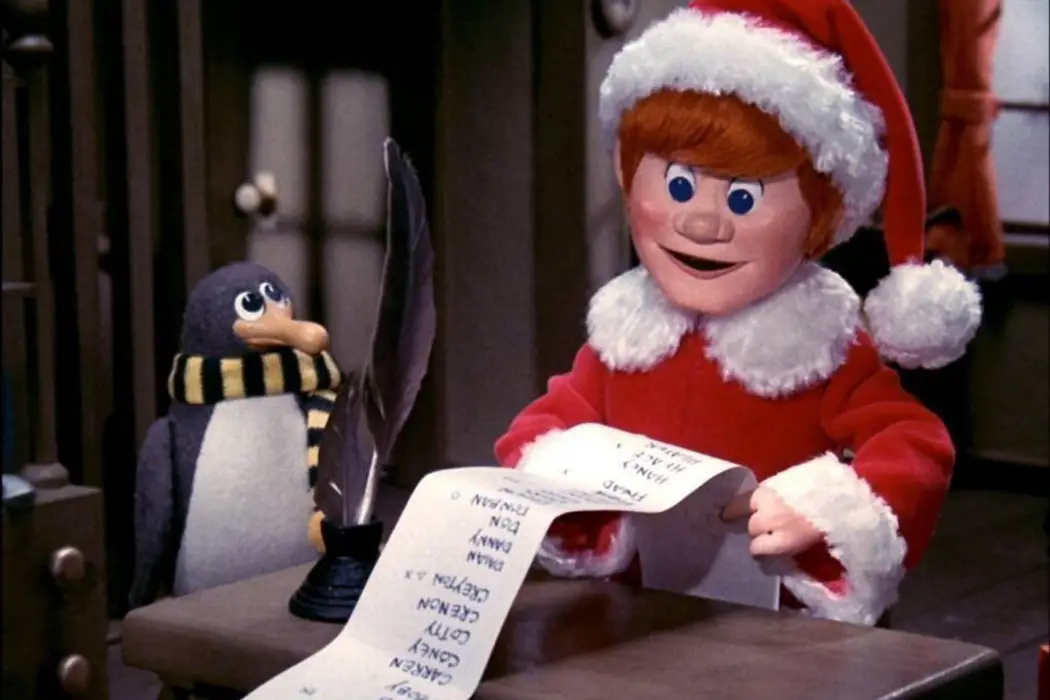
Film critic, Ithaca College graduate, University of St Andrews masters…
Christmas in Nazi Germany was as twisted as one might expect. German families ate swastika-shaped cookies, decorated fir trees with “traditional” Nordic runes, and sang hymns rewritten to avoid reference to God, Christ, and Christianity. Since Jesus is one of the most prominent Jews in history, the Nazi party went to war with the holiday that celebrated his birth. The Nazis were also becoming increasingly wary of organized religion. They even tried to replace the birth of Christ with the coming of Adolf Hitler — the “Saviour Führer,” they called him.
In the years of the imbruted Nazi regime and the decades that followed, the relationship between Germany and Christmas was battered and threadbare. This battle of Nazis versus Christmas forms the unusual narrative backbone of a bizarre yet beloved Christmas classic: the 1970 stop-motion animated special Santa Claus is Comin’ to Town.
Burgermeister Meisterburger And His Nazi Regime
Santa Claus is Comin’ to Town, celebrating its 50th anniversary this year, is a Rankin/Bass production following the studio’s other stop-motion Christmas specials, like Rudolph the Red-Nosed Reindeer and The Little Drummer Boy. It was first broadcast on television in 1970, with a screenplay from studio regular Romeo Muller. In my review of Rudolph the Red-Nosed Reindeer and its blatant queer narrative, I said that Santa Claus Is Comin’ to Town “recasts Santa as a Christ figure and posits that Jesus could have stopped the Holocaust,” which is not the kind of summary you just drop on people without some kind of follow-up.
Santa Claus is Comin’ to Town is Santa’s origin story, and the action takes place “in one of the northern countries,” explains our narrator, S.D. Kluger (voiced by Fred Astaire, because why not). The village where Muller lays our scene is Sombertown, a miserable little municipality where the townspeople wear black, nobody has sex, and they’re all probably starving.
Burgermeister Meisterburger (Paul Frees) reigns over Sombertown, gorging himself while the citizenry goes hungry and relying on his militia to keep the peace. The soldiers all dress in anachronistic World War I clothing, complete with Pickelhauben spiked helmets. I think Burgermeister, whom the troops call “Herr Burgermeister,” is actually supposed to be a king. But because the special’s portrayal of a generic Prussian town mixes 18th-century culture with 19th-century Pickelhaubens and 20th-century Nazism, it’s hard to get a read on the particulars of its allegory.
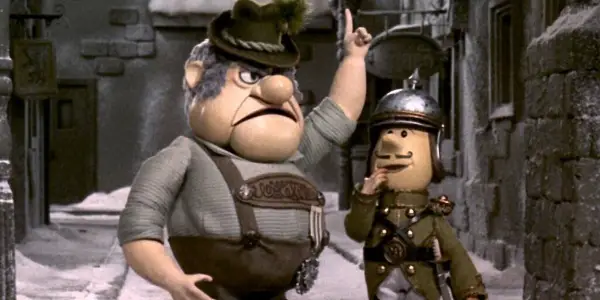
Burgermeister is obviously intended to be a Hitler composite. He’s a lunatic despot with extreme prejudice — here, it’s against toys — and he and his soldiers all speak with heavy German accents while the townspeople and Santa’s posse sound like Americans.
His war on toys stems from his deep loathing for his citizens’ happiness (I guess Sombertown has a name to live up to). After he slips on a toy while descending the capitol stairs, he winds up in the hospital. “A toy?” he asks his lieutenant, incredulously. “Just as I suspected… I hate toys. And toys hate me! Either they are going, or I am going… and I am certainly not going.” He demands all tin soldiers be melted down, ballerina dolls arrested, and toy boats sunk. “Toys are hereby declared illegal, immoral, unlawful, and anyone found with a toy in his possession will be placed under arrest and thrown in the dungeon,” he says.
Burgermeister threatens to arrest children, institutes a curfew, and mandates all doors and windows be locked after sundown, and he and his regime conduct nightly raids on homes to search for toys that might be hiding (read: under floorboards or inside pianos). “Search the premises! If you find so much as one marble or half a jack, the whole house is under arrest!” he shouts to his soldiers while a family cowers in the foyer.
The extremity of Burgermeister’s laws has real-world counterparts in the Nuremberg Laws, which established in Germany a race-based state and facilitated nationwide book burnings. After Kristillnacht, further anti-Jewish legislation led to mass arrests and death sentences to anyone harboring Jews.
Burgermeister holds a toy burning in the town square. “Children of Sombertown!” he shouts, holding a torch to the toys. “You will never play again!” He sets them alight in the middle of town in front of the children, and his soldiers watch wooden ducks and dollhouses go up in flames the same way Nazis watched book pages twist and turn to ash in the fire.
Santa The Christ Figure
Burgermeister and his Nazi regime rage against Christmas itself, the same way Hitler’s party did in the 1930s and ’40s. Christmas is personified in Kris Kringle (Mickey Rooney), whose genesis is raised to biblical heights with religious imagery and classic Christian hero mythology. His origin evokes the stories of many prophets before him.
Kris first enters Burgermeister’s court as an orphan, like Moses, Esther, and Jesus. The note affixed to his blanket spells out his destiny like Kris is living in a bad YA novel: “He will be exceptional,” the note predicts, “if only given the love he needs.”
Burgermeister doesn’t have time for this shit and orders the baby sent to the orphanage outside of town. En route, however, Kris’ sleigh is blown away by a strong wind. Like Moses in the reed basket, he’s blown up a mountain and into the woods and eventually lands at the doorstep of an eminent family.
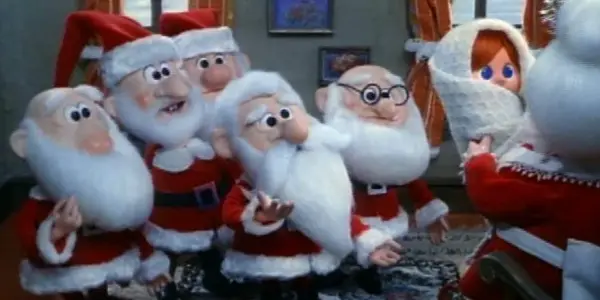
From there, the Christian hero themes lay dormant — though Kris’ odyssey through the realm of the Winter Warlock can be likened to Jesus’ 40 days of temptation in the wilderness, and his kinship with the animals of the woods can be connected to, well, take your pick of biblical heroes. The Judeo-Christianity of it all comes back when Burgermeister has outlawed Santa from making toy deliveries to Sombertown, but Kris gets the band back together to do one last job, risking it all to deliver… a toy Noah’s Ark to an ailing little girl.
Kris, like Jesus, performs miracles for the townspeople — not only does he bring joy and cheer to Sombertown’s children, but he can also read the future, read people’s minds, make reindeer fly, and grow the worst beard in the world. When faced with Burgermeister’s resentment, Kris can’t even bring himself to hate the Sombertown monarch. The messiah didn’t come to hate. He came to break into homes and befriend warlocks, and he’s all out of warlocks.
Many of the religious themes crystallize at his wedding to the town’s schoolteacher, Miss Jessica (Robie Lester). Astaire tells us, “They stood before the Lord in silent winter woods, and a grove of pine trees was their cathedral.” Perplexingly, the Winter Warlock (Keenan Wynn) has to pray to God for a little magic. The magic is the whole point of Santa Claus! Yet in his origin story, we’re shown that the magic of Christmas isn’t even the most powerful force in the world. Santa and the Warlock answer to a higher power. (Hint: It’s God.)
Cementing the Christ connection, Kris and Jessica’s wedding song, “What Better Way To Tell You,” directly references the birth of Jesus and draws a straight line from the biblical Magi bringing gifts to Santa and Jessica swapping presents at their wedding. “The custom started long, long ago,” Astaire sings, “When first the Wise Men three/ Gave gifts of love, of love/ To a newborn baby.” (Most of the songs are terrible.)
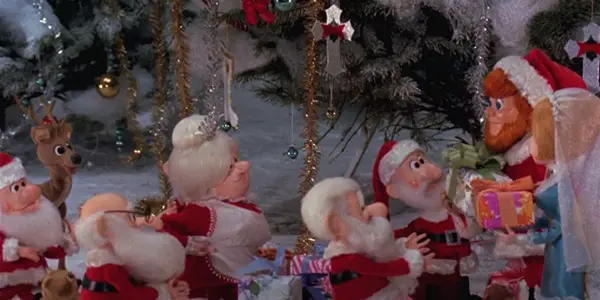
At the special’s conclusion, we’re reminded that Christmas Eve is the “holiest night of the year” and that Santa’s story, like all stories in the Scripture, has moral lessons you’re supposed to draw from it. I may have only half–paid attention in Sunday School, but the last minute of Santa Claus is Comin’ to Town feels like exactly the kind of stuff we’d watch, ending by connecting Santa to themes of charity, compassion, and the deep, abiding love of God.
The Judaism Of Toys
By far, the most interesting aspect of the special is its complicated allegory for the persecution of Jewish people by the Nazi regime. Within the allegory, the toys are meant to represent the Jews. That sounds uncomfortable, demeaning, and a little jokey, but consider the Jewish people’s long history of objectification by Prussia and the German Empire. In Amos Elon’s The Pity of It All, an examination of Germany’s Jews from 1743 to the rise of the Third Reich, he writes that the Jew in Prussia was “stripped of rights and reduced to a commodity, like hay or cattle.” The only way Jews could enter 18th-century Berlin was through a gate reserved for livestock.
There’s also the matter of how readily the town accepts Burgermeister’s anti-toy legislation. All of Sombertown immediately goes along with it. Even Miss Jessica, the new schoolteacher, unquestioningly accepts that toys are now illegal and pose a threat to the state. They’re easily scapegoated for the town’s problems.
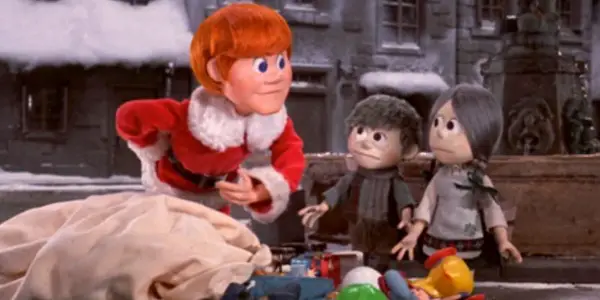
Santa Claus is Comin’ to Town, however, masterfully keeps throwing so much shit at you that you can’t even think about the Holocaust allegory at its core. Santa, for example, sings a whole song about how children need to sit on his lap and pay him with kisses if they want toys, which is some grade-A creepy shit. (The song is cut or abridged for most network broadcasts.)
Jessica sings a ’70s fantasia power ballad. Burgermeister plays with a yo-yo. And there’s this odd penguin sidekick, Topper — what the hell use is Topper, anyway? He does zilch to move the story along. He isn’t helpful, funny, or clever. He reeks of a network exec seeing storyboards and saying, “Hmm, Santa running around this wretched sooty town with his sack of toys just doesn’t feel right… I know! Add a penguin in! A penguin sidekick! And give him a little rugby scarf!”
The Elf Conundrum
Santa Claus is Comin’ to Town is loosely based on the hit song of the same name, in the same way that the film Battleship, in which Liam Neeson and Rihanna fight aliens at sea, is based on the board game. It’s a baffling thing to remember, given that so much of Santa Claus is Comin’ to Town has no basis in the song. Take the elf family, the Kringles, for instance — they live over the Winter Warlock’s mountain in Rainbow River Valley, and they take young Kris in when he’s Moses’d to their doorstep.
The matriarch, Tanta Kringle (Joan Gardner), is the only nice German-accented character, as opposed to the Nazis of Sombertown. The Kringles, she tells us via song, used to be “world-renowned” and served royalty, a detail that not only isn’t in the original song but has no bearing on the story whatsoever — they could come from a long line of bowling alley owners and it wouldn’t make any difference. The only aspect of the story this decision impacts is the Jewish subtext.
Elon writes in The Pity of It All about the ancient renown earned by Jewish intellectuals in the Middle Ages. “They constituted an early urban middle class of traders, surgeons, apothecaries, and craftsmen in gold, silver, and precious stones,” he writes. That’s true of the Kringles as well — nowhere in Sombertown, where it’s insinuated they used to work, do we see signs of a middle class. The only job in town seems to be as a member of Burgermeister’s militia, which religious structures would have prevented Jews from pursuing. The Kringles are the only craftspeople we see in the film. (Some critics have claimed the warlock is a Jewish character, but we learn so little about him that I could not honestly speak on this.)
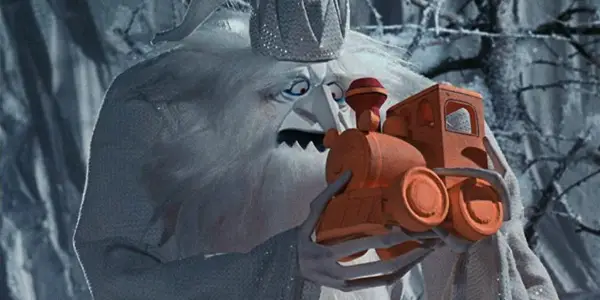
Elon also writes about the “court Jews,” a small elite crowd of privileged Jewish people who directly controlled court finances and goods — a uniquely German system. The Kringles fit into both of these categories, existing as a reminder of the history of Jewish people in Germany. Since they raise him, the Kringles map their Jewish culture and heritage onto Kris. When he sets out for Sombertown with toys in a sack on his back, he embodies the harsh Betteljuden lifestyle many Jewish nomads had to adopt.
Conclusion: Saving Christmas
For all the special’s allegorizing about Nazism and the rise of fascism in Germany, Santa Claus is Comin’ to Town ends with a really odd sweeping under the rug. “The Meisterburgers,” says Kluger, “kinda died off and fell out of power. And by and by, the good people realized how silly the Meisterburger laws were. Well, everybody had a wonderful laugh and forgot all about him.” Sorry, Fred Astaire, but a jolly f*cking laugh and the mass realization of an old leader’s flaws aren’t enough to ensure that history never repeats itself. This is wish-fulfillment fantasy and, as fascism in the real world post-1945 has taught us, is a complete and total cop-out.
A better encapsulation of fascism is “Put One Foot in Front of the Other,” a whole song Kris sings to the warlock about how easy it is to change your attitude. In the film, the song has a positive connotation about changing your outlook to become a better, happier person and melting the warlock’s icy heart. But the song also describes the slippery slope of fascism and how systemic oppression can gradually morph into genocide. One thing leads to another, and soon you’ll be walking out the door.
Santa Claus is Comin’ to Town feels like two films: one is a Santa Claus origin story with claustral Christian themes; the other is a more secular film that boldly tackles the history of Jewish persecution in Germany and features pretty on-the-nose Nazi imagery. Through its use of alternate history — depicting Santa as a Christlike figure who, if he were around in the 1930s, could have stopped Germany’s fall to fascism — the film turns a quintessentially transcendent, non-Christian story into an overtly religious one. It feels catfishy, like it’s indoctrinating children into religion. But at the same time, isn’t that why Topper is there? And the songs? And the warlock? To distract you from the religious themes?
As for Germany’s prolonged conflict with Christmas, Nazi attempts to invent more “Germanic” and “traditional” roots for the holiday were unsuccessful, though some of the practices and revised hymns stuck around for a few decades. The German Democratic Republic launched a similar de-Christianization movement in the 1950s, but this too failed.
The nation had bounced back by the ’60s and ’70s. Germany grew wealthier, Christmas became the focal point of the retail calendar year, and by the 1980s, the country had arrived at the state of mass consumerism that had itself consumed the majority of the Western world. Germany never won the fight against Santa Claus, Christmas was saved, and for only $79.99 on Amazon, you can buy a Hallmark ornament of the Winter Warlock and his old pal, Topper the penguin.
What do you think of Santa Claus is Comin’ to Town? What’s your favorite Rankin/Bass special? Comment below with your thoughts.
Watch Santa Claus is Comin’ to Town
Does content like this matter to you?
Become a Member and support film journalism. Unlock access to all of Film Inquiry`s great articles. Join a community of like-minded readers who are passionate about cinema - get access to our private members Network, give back to independent filmmakers, and more.
Film critic, Ithaca College graduate, University of St Andrews masters student, head of the "Paddington 2" fan club.












